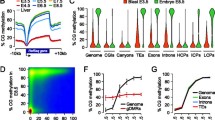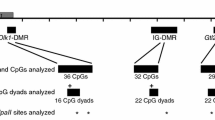Abstract
The gene MEG3 is located in the imprinted human chromosomal region on 14q32. Imprinting of a structurally homologous region IGF2/H19 on 11p15 is mediated through cytosine methylation-controlled binding of the protein CTCF to target sites upstream of H19. We identified five new CTCF binding sites around the promoter of MEG3. Using an electrophoretic mobility shift assay, we showed that these sites bind CTCF in vitro. Using one of these sites, chromatin immunoprecipitation (ChIP) analysis confirmed CTCF binding in-vivo, and differential allele-specific methylation was demonstrated in seven individuals with either maternal or paternal uniparental disomy 14 (UPD14). The site was unmethylated on the maternally inherited chromosomes 14 and methylated on the paternally inherited chromosomes 14, suggesting parent-specific methylation of sequences upstream of MEG3. We speculate that this CTCF-binding region may provide a mechanism for the transcriptional regulation of MEG3 and DLK1.
Similar content being viewed by others
References
Antonarakis SE, Blouin JL, Maher J, Avramopoulos D, Thomas G, Talbot CC, Jr (1993) Maternal uniparental disomy for human chromosome 14, due to loss of a chromosome 14 from somatic cells with t(13;14) trisomy 14. Am J Hum Genet 52: 1145–1152.
Bell AC, Felsenfeld G (2000) Methylation of a CTCF-dependent boundary controls imprinted expression of the Igf2 gene. Nature 405: 482–485.
Bell AC, West AG, Felsenfeld G (1999) The protein CTCF is required for the enhancer blocking activity of vertebrate insulators. Cell 98: 387–396.
Berend SA, Bejjani BA, McCaskill C, Shaffer LG (2002) Identification of uniparental disomy in phenotypically abnormal carriers of isochromosomes or Robertsonian translocations. Am J Med Genet 111: 362–365.
Bird AP (1995) Gene number, noise reduction and biological complexity. Trends Genet 11: 94–100.
Charlier C, Segers K, Karim L et al. (2001a) The callipyge mutation enhances the expression of coregulated imprinted genes in cis without affecting their imprinting status. Nat Genet 27: 367–369.
Charlier C, Segers K, Wagenaar D et al. (2001b) Human–ovine comparative sequencing of a 250-kb imprinted domain encompassing the callipyge (clpg) locus and identification of six imprinted transcripts: DLK1, DAT, GTL2, PEG11, antiPEG11, and MEG8. Genome Res 11: 850–862.
Chung JH, Whiteley M, Felsenfeld G (1993) A 5′ element of the chicken beta-globin domain serves as an insulator in human erythroid cells and protects against position effect in Drosophila. Cell 74: 505–514.
Chung JH, Bell AC, Felsenfeld G (1997) Characterization of the chicken beta-globin insulator. Proc Natl Acad Sci USA 94: 575–580.
Coveler KJ, Yang SP, Sutton R et al. (2002) A case of segmental paternal isodisomy of chromosome 14. Hum Genet 110: 251–256.
Croteau S, Charron MC, Latham KE, Naumova AK (2003) Alternative splicing and imprinting control of the Meg3/Gtl2-Dlk1 locus in mouse embryos. Mamm Genome 14: 231–241.
Engel E (1980) A new genetic concept: uniparental disomy and its potential effect, isodisomy. Am J Med Genet 6: 137–143.
Filippova GN, Thienes CP, Penn BH et al. (2001) CTCF-binding sites flank CTG/CAG repeats and form a methylation-sensitive insulator at the DM1 locus. Nat Genet 28: 335–343.
Georgiades P, Chierakul C, Ferguson-Smith AC (1998) Parental origin effects in human trisomy for chromosome 14q: implications for genomic imprinting. J Med Genet 35: 821–824.
Hark AT, Schoenherr CJ, Katz DJ, Ingram RS, Levorse JM, Tilghman SM (2000) CTCF mediates methylation-sensitive enhancer-blocking activity at the H19/Igf2 locus. Nature 405: 486–489.
Kanduri C, Holmgren C, Pilartz M et al. (2000a) The 5′ flank of mouse H19 in an unusual chromatin conformation unidirectionally blocks enhancer-promoter communication. Curr Biol 10: 449–457.
Kanduri C, Pant V, Loukinov D et al. (2000b) Functional association of CTCF with the insulator upstream of the H19 gene is parent of origin-specific and methylation-sensitive. Curr Biol 10: 853–856.
Kobayashi S, Wagatsuma H, Ono R et al. (2000) Mouse Peg9/Dlk1 and human PEG9/DLK1 are paternally expressed imprinted genes closely located to the maternally expressed imprinted genes: mouse Meg3/Gtl2 and human MEG3. Genes Cells 5: 1029–1037.
Lewis A, Murrell A (2004) Genomic imprinting: CTCF protects the boundaries. Curr Biol 14: R284–R286.
McGowan KD, Weiser JJ, Horwitz J et al. (2002) The importance of investigating for uniparental disomy in prenatally identified balanced acrocentric rearrangements. Prenat Diagn 22: 141–143.
Miyoshi N, Wagatsuma H, Wakana S et al. (2000) Identification of an imprinted gene, Meg3/Gtl2 and its human homologue MEG3, first mapped on mouse distal chromosome 12 and human chromosome 14q. Genes Cells 5: 211–220.
Morison IM, Reeve AE (1998) A catalogue of imprinted genes and parent-of-origin effects in humans and animals. Hum Mol Genet 7: 1599–1609.
Ohlsson R, Renkawitz R, Lobanenkov V (2001) CTCF is a uniquely versatile transcription regulator linked to epigenetics and disease. Trends Genet 17: 520–527.
Paulsen M, Takada S, Youngson NA et al. (2001) Comparative sequence analysis of the imprinted Dlk1-Gtl2 locus in three mammalian species reveals highly conserved genomic elements and refines comparison with the Igf2-H19 region. Genome Res 11: 2085–2094.
Pentao L, Lewis RA, Ledbetter DH, Patel PI, Lupski JR (1992) Maternal uniparental isodisomy of chromosome 14: association with autosomal recessive rod monochromacy. Am J Hum Genet 50: 690–699.
Prawitt D, Enklaar T, Gartner-Rupprecht B et al. (2005) Microdeletion of target sites for insulator protein CTCF in a chromosome 11p15 imprinting center in Beckwith–Wiedemann syndrome and Wilms' tumor. Proc Natl Acad Sci USA 102: 4085–4090.
Robin NH, Harari-Shacham A, Schwartz S, Wolff DJ (1997) Duplication 14(q24.3q31) in a father and daughter: delineation of a possible imprinted region. Am J Med Genet 71: 361–365.
Sasaki H, Ishihara K, Kato R (2000) Mechanisms of Igf2/H19 imprinting: DNA methylation, chromatin and long-distance gene regulation. J Biochem (Tokyo) 127: 711–715.
Schiff R, Reddy P, Ahotupa M et al. (2000) Oxidative stress and AP-1 activity in tamoxifen-resistant breast tumors in-vivo. J Natl Cancer Inst 92: 1926–1934.
Schmidt JV, Matteson PG, Jones BK, Guan XJ, Tilghman SM (2000) The Dlk1 and Gtl2 genes are linked and reciprocally imprinted. Genes Dev 14: 1997–2002.
Schuster-Gossler K, Bilinski P, Sado T, Ferguson-Smith A, Gossler A (1998) The mouse Gtl2 gene is differentially expressed during embryonic development, encodes multiple alternatively spliced transcripts, and may act as an RNA. Dev Dyn 212: 214–228.
Sparago A, Cerrato F, Vernucci M, Ferrero GB, Silengo MC, Riccio A (2004) Microdeletions in the human H19 DMR result in loss of IGF2 imprinting and Beckwith–Wiedemann syndrome. Nat Genet 36: 958–960.
Sutton VR, Shaffer LG (2000) Search for imprinted regions on chromosome 14: comparison of maternal and paternal UPD cases with cases of chromosome 14 deletion. Am J Med Genet 93: 381–387.
Sutton VR, Coveler KJ, Lalani SR, Kashork CD, Shaffer LG (2002) Subtelomeric FISH uncovers trisomy 14q32: lessons for imprinted regions, cryptic rearrangements and variant acrocentric short arms. Am J Med Genet 112: 23–27.
Szabo PE, Tang SH, Silva FJ, Tsark WM, Mann JR (2004) Role of CTCF binding sites in the Igf2/H19 imprinting control region. Mol Cell Biol 24: 4791–4800.
Takada S, Tevendale M, Baker J et al. (2000) Delta-like and gtl2 are reciprocally expressed, differentially methylated linked imprinted genes on mouse chromosome 12. Curr Biol 10: 1135–1138.
Towner D, Yang SP, Shaffer LG (2001a) Prenatal ultrasound findings in a fetus with paternal uniparental disomy 14q12-qter. Ultrasound Obstet Gynecol 18: 268–271.
Towner DR, Shaffer LG, Yang SP, Walgenbach DD (2001b) Confined placental mosaicism for trisomy 14 and maternal uniparental disomy in association with elevated second trimester maternal serum human chorionic gonadotrophin and third trimester fetal growth restriction. Prenat Diagn 21: 395–398.
Walter CA, Shaffer LG, Kaye CI et al. (1996) Short-limb dwarfism and hypertrophic cardiomyopathy in a patient with paternal isodisomy 14: 45,XY,idic(14)(p11). Am J Med Genet 65: 259–265.
Wolffe AP (2000) Transcriptional control: imprinting insulation. Curr Biol 10: R463–R465.
Wylie AA, Murphy SK, Orton TC, Jirtle RL (2000) Novel imprinted DLK1/GTL2 domain on human chromosome 14 contains motifs that mimic those implicated in IGF2/H19 regulation. Genome Res 10: 1711–1718.
Yu W, Ginjala V, Pant V et al. (2004) Poly(ADP-ribosyl)ation regulates CTCF-dependent chromatin insulation. Nat Genet 36: 1105–1110.
Zhang X, Zhou Y, Mehta KR et al. (2003) A pituitary-derived MEG3 isoform functions as a growth suppressor in tumor cells. J Clin Endocrinol Metab 88: 5119–5126.
Zimarino V, Wu C (1987) Induction of sequence-specific binding of Drosophila heat shock activator protein without protein synthesis. Nature 327: 727–730.
Author information
Authors and Affiliations
Corresponding author
Additional information
†These authors contributed equally to this work.
Rights and permissions
About this article
Cite this article
Rosa, A.L., Wu, YQ., Kwabi-Addo, B. et al. Allele-specific methylation of a functional CTCF binding site upstream of MEG3 in the human imprinted domain of 14q32. Chromosome Res 13, 809–818 (2005). https://doi.org/10.1007/s10577-005-1015-4
Received:
Revised:
Published:
Issue Date:
DOI: https://doi.org/10.1007/s10577-005-1015-4




